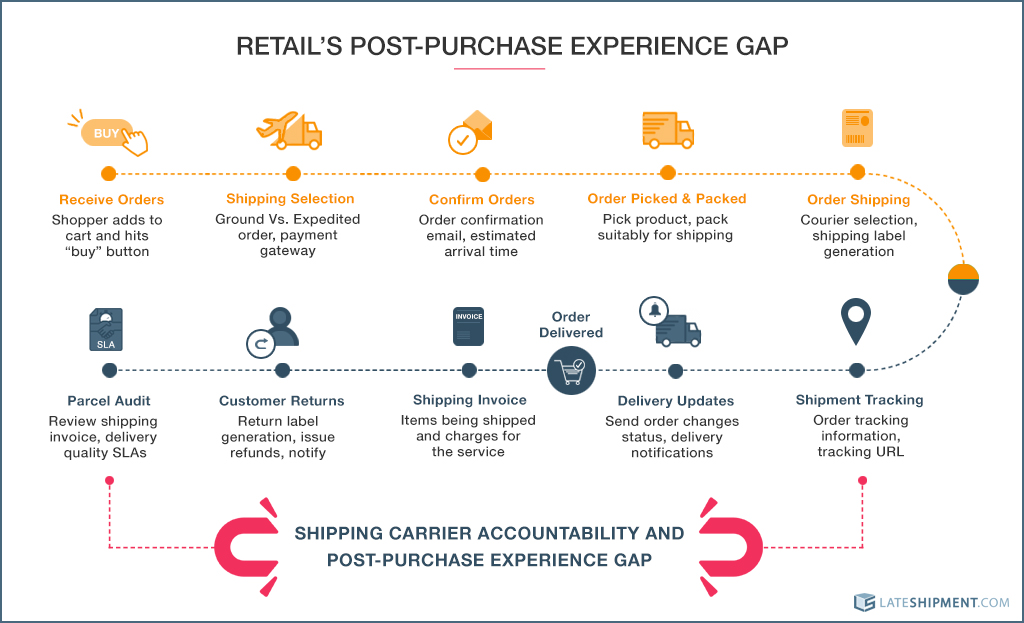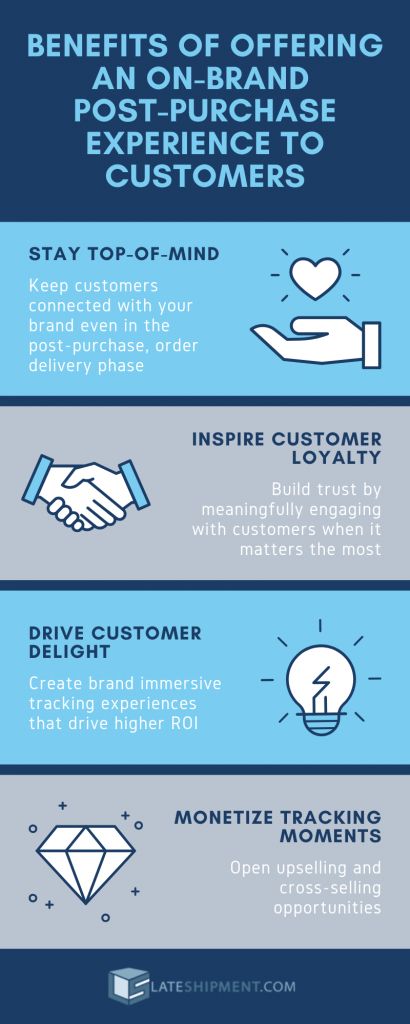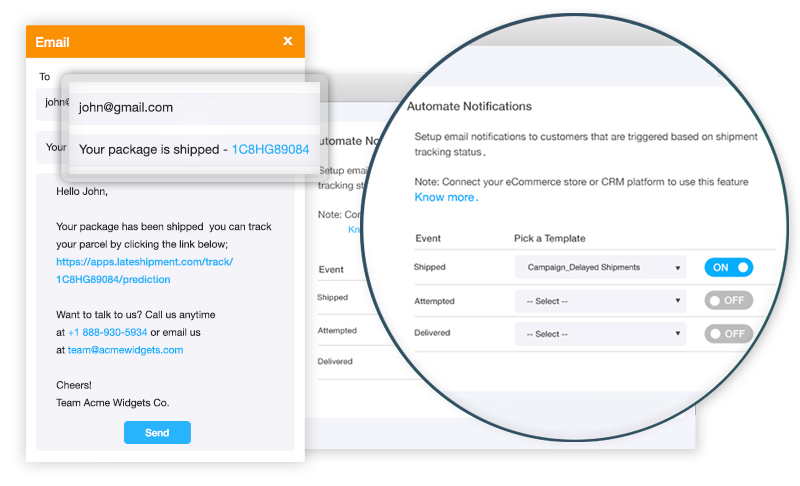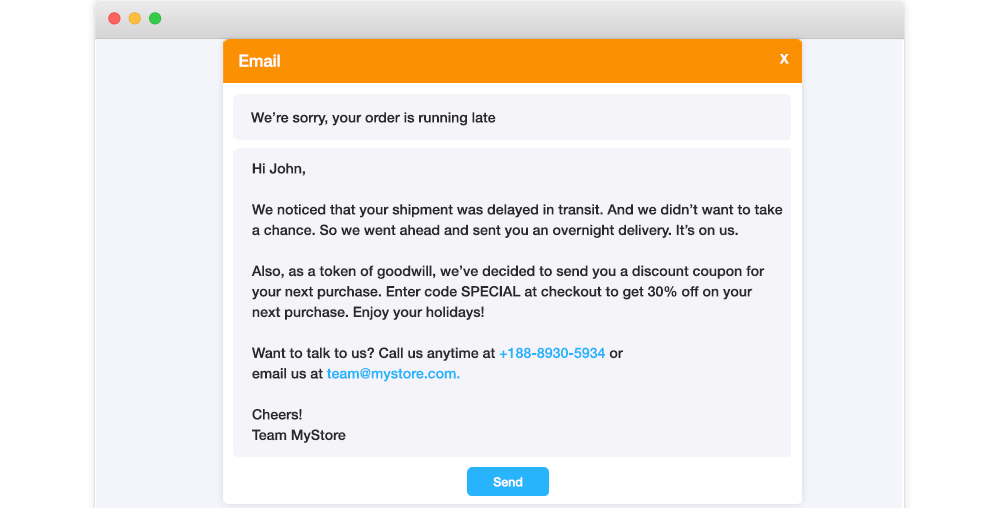We live in an experience economy. Experience is everything.
Consumers own brand perception. And experience drives how consumers perceive a brand.
Be it their journey to the checkout phase or their post-purchase, last-mile delivery phase, it is imperative that you provide customers with an experience that builds trust, is delightful, and creates a positive brand perception.
With companies like Amazon, Walmart, and eBay rewriting the eCommerce playbook from a “delivery speed” and “customer experience” standpoint, your brand needs to exceed customer expectations to stand out among your competition.
The Post-Purchase Experience Gap

The time starting from when a retailer ships a package to when it is in the hands of a customer defines the customer’s post-purchase experience.
Retailers have exclusive control of the customer experience they offer from the point a customer is browsing on their website up until the moment the product is shipped.
But this is where problems begin to crop up. Shipping is mostly looked at as a third-party function with retailers often considering their job done once a parcel has been handed off to the shipping carrier.
The truth, unfortunately, is that, regardless of how efficient shipping carriers are, 8 to 10 percent of parcels inevitably get delayed. This results in a situation where a significant percentage of customers are set up for disappointment.
The reason why this issue must be considered as a top priority is that when delivery delays do happen, customers more often than not point fingers at the retailer rather than at the shipping carrier.
What is an On-Brand Post-Purchase Experience?
The dictionary definition of on-brand states that whatever you’re creating is consistent with the look, feel, messaging, tone, voice, etc. of the brand you’ve built.
In layman’s terms, a branded post-purchase customer experience is not just providing “an experience” but rather “the experience”.
There are several ways to provide memorable post-purchase customer experiences that align with your brand beginning with sending customers an order confirmation mail.
But there are certain guidelines that retailers must follow to create a memorable delivery experience for customers from an on-brand perspective.
Principles of Creating an On-Brand Post-Purchase Experience in the Last-Mile
Creating an on-brand post-purchase customer experience in the last-mile involves two aspects
- Customer Engagement – Engaging with your customers via notifications that associate with your brand’s tone, voice, language, etc.
- Brand Identity Elements – Creating on-brand tracking experiences via self-service tracking tools that align with the visual aspects of your brand such as color schemes, design, fonts, etc.
Let’s go over these aspects in detail.
1. Customer Engagement
Customer engagement is all about communicating with customers when it matters and forging relationships that last.
Engaged customers are loyal customers and it should be your mission to meaningfully engage with them at every stage.
It is a fact that highly engaged customers buy more, promote more, and demonstrate more loyalty. Research shows that a fully-engaged customer represents 23% more revenue than average.
Keep your customers informed through timely notifications in the form of automated or customized emails, SMSes, and more. This way, you can make more of a mark on your customers and indeed, delight them.
1.1 Automated notifications
Every customer of yours is anxious about their parcels in transit. This anxiety immediately leads to frustration and constant bombardment of your support team with WISMO calls.
You can make use of technology to send automated email notifications for certain checkpoints in an order’s delivery lifecycle such as “your order has been shipped”, “your order is in-transit” etc. and provide customers a link, allowing them to track their order.
You can edit these mail templates based on your brand’s language, color schemes, and other elements.
One of the perks of these emails is that you can personalize them by calling customers by their names or preferred nicknames or use emojis or audio-visual content to make them as engaging as possible.
1.2 Customized notifications
Parcel delays in eCommerce are inevitable. Period.
What doesn’t help is the fact that shipping carriers tend to withhold information about delivery mishaps such as delays from their tracking pages.
Moreover, shipping carriers are not as invested in the success of a specific parcel from a specific retailer as the retailer themselves. Consequently, they tend to treat the parcel only as a constituent of a larger consignment.
The responsibility lies with the retailer to provide their customers with the best possible post-purchase experience despite the challenges involved.
When you come to know that your customer’s parcel is delayed in transit, you can proactively inform them that their order is going to reach them late and offer solutions based on their expectations such as
- re-shipping the order via an expedited shipping option
- offer a discount or a refund on their next purchase.
You can brand this touchpoint by reinforcing your brand identity with customers.
1.3 SMS notifications
Notifications only over email are insufficient in this day and age. SMS notifications are also required as customers nowadays shop and track parcels on mobile phones as well. In this context, it is pertinent to keep the following in mind:
- Most of us don’t check emails on a regular basis.
- SMSes have a sense of urgency compared to mails.
- There is a high probability that your mails can get filtered out of your customer’s inbox and end up in their spam folder.
- If there’s any change in your customer’s order, it is easier to send out a quick SMS notification compared to a long email.
2. Brand Identity Elements
Once a shipping carrier takes custody of a parcel, they share a tracking URL with the retailer, who then shares it with the customer concerned.
Beyond this stage, shipping status information is periodically updated on the carrier’s tracking page, which the customer accesses to know of parcel status.
However, there is a significant downside to this.
a) The carrier’s tracking page lacks certain information while engaging with the customer
Carriers fail to inform about delivery exceptions such as delays, which is not what your customers want.
This is why you can create your own custom branded tracking page that
- Gives you control of the post-purchase experience you offer your customers
- Provides your customers with the constant, detailed updates they’re looking for
b) The shipping-carrier-provided tracking page is a lost opportunity to engage with and monetize shoppers
The carrier tracking page is devoid of any brand personality or tone of voice, visually boring, and a marketing dead-end (not encouraging any further brand interaction).
Worry not though. There’s a better way to do tracking.
Rather than taking your customers to the carrier’s tracking page, you can direct them to your own tracking page that contains your unique language and color schemes, thus enhancing brand recognition and keeping your brand top of mind with your audiences.
You can also drive sales by subtly populating your tracking page with similar product suggestions and through upselling and cross-selling opportunities for your business, thereby boosting your bottom line over time.
Advantages of On-Brand Post-Purchase Experience

Creating an on-brand post-purchase customer experience has a gamut of benefits for both customers and retailers.
- Keep your customers in the know of their parcel’s status and stay connected with them even in the post-purchase, order delivery phase.
- Meaningfully engage with them regarding any delivery exception such as delays to build trust and increase customer loyalty.
- Driving brand immersive tracking experiences for your customer leads to an increased Customer Lifetime Value (CLV) and in turn ROI.
- Gain access to increased monetization opportunities on tracking moments with engaging marketing assets such as personalized recommendations and offers.
How LateShipment.com can Help You Provide an On-Brand Post-purchase Experience
LateShipment.com’s Delivery Experience Management (DEM) suite is chock-a-block filled with benefits for your business to provide an on-brand post-purchase experience. Read on to explore some of these.
Branded Customer Notifications

DEM helps you set up automated email and SMS notifications that are triggered and sent to customers when their parcels reach specific events during the shipping process.

DEM also provides you with the ability to send custom notifications to specific customers whose parcels are experiencing uncommon delays like unexpected weather exceptions.
All you have to do is verify your domain to make sure that the mail you send doesn’t end up in your customer’s spam folder. We take it from there.
Some of the features of the solution are –
- Trigger automated notifications based on shipment status such as “shipped”, “attempted” or “delivered”.
- In order to send notifications with ease, we provide built-in mail tags such as customer name, email id/phone number, order number, etc.
- You need to connect your eCommerce store or CRM platform to use this feature, which is why we integrate with every major eCommerce and CRM platform.
- You can also edit the mail templates based on your brand’s language, tone of voice, etc.
Custom Branded Tracking Page
DEM provides you with the ability to create a branded tracking page that contains all necessary information about the package such as carrier and service information; shipped and delivery date; the current status of the package, with location; and the recent update shown as a priority.
If you have integrated your CRM platform, your customers can see additional details such as weight, order number, etc.
Additionally, the tracking page contains a Delivery Satisfaction (DSAT) score system through which, your customers can rate the delivery performance, which in turn helps you monitor your carrier’s performance. You can also link your tracking page to your Google Analytics account to know how your brand is perceived by your customers.
DEM also helps retailers add a tracking widget anywhere on their website such as on the order confirmation/ history page. Customers can enter the tracking number on the widget, which will redirect them to the branded tracking page.
In spite of the sky-high costs, tedious process, and accumulated complications, last-mile delivery will always remain the decisive leg of the supply chain process.
At LateShipment.com, our focus has remained steadfastly on the last mile, typically the part of the logistics chain that is the most opaque.
LateShipment.com is the world’s only logistics cloud tool that helps businesses of every size reduce shipping costs by up to 20% and provide memorable delivery experiences to customers at scale.
The best part is, it takes less than 2 minutes to see LateShipment.com in action.
COVID-19 Note: To help tide over the current crisis, we are giving all businesses full and free access to our Delivery Experience Management Platform till June 30, 2020.
The value we add to businesses is most evident when experienced first-hand.
It’s that simple!



